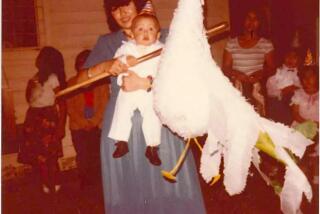Mother Teresa Followers Carry Out Memorial to Her Charity
It was an unsung memorial, delivered in a place and a way that Mother Teresa doubtless would have savored.
A blue and white Ford van, serving as a battered vessel of the famous missionaryâs spirit, was crammed full of food and faithful followers as it bobbed to a stop Saturday morning in one of Central Los Angelesâ fouler back alleys.
From a still row of tarp and wood lean-tos emerged a woman, a soiled T-shirt down to her knees. In an instant, served and servers were locked in knowing embraces.
âIâll say a prayer for Mother,â 42-year-old Debra Williams, still a bit groggy, softly consoled her visitors. âI love you guys.â
Since hearing of Mother Teresaâs death, Williams had been thinking of the band of men, women and children who show up like clockwork each week with food, clothing, blankets, friendly chitchat and hugs. âItâs sad,â she said.
But if anything, Brother James Walker, Brother Bob Theis and half a dozen other members and volunteers from Mother Teresaâs Missionaries of Charity seemed almost upbeat.
After celebrating an early morning Mass in their leaderâs honor at the orderâs Pico-Union house--one of three congregations the Nobel Peace Prize winner established in the Los Angeles area--they headed out with hundreds of sandwiches, gallons of iced tea and boxes of pastries.
âHer spirit is alive in us,â said Brother Bob, as dozens of hungry men and families gathered around the first stop, a bench in MacArthur Park.
Brother Bobâs sentiments were shared by many across the world, who found in their grief a renewed dedication to Mother Teresaâs legacy of service. Those who met her, even for the briefest of handshakes, recalled her ability to make them feel as if they âwere the only person in the world.â
Jean Sudbeck initially felt only shock and despair at the news. The 62-year-old Tustin woman visited briefly with Mother Teresa on five occasions at the nunâs Calcutta home.
âThere was an energy that radiated from her,â said Sudbeck, whose small missionary group, Wings of Glory International, has woven 50,000 rosaries out of cord for the poor in India. âIt was so magnetic that when you left her you felt you could just go out and change the whole world.â
Sudbeck, who continued to speak of Mother Teresa in the present tense, said the diminutive nun was home to welcomed anyone who came to her door in Calcutta.
âWhen you go to her home, if sheâs there, sheâll come out to greet you,â Sudbeck said through tears. âItâs like being able to drop in on your neighbor for a cup of coffee. It almost takes your breath away she is so warm and personable.â
Sudbeck said she and seven other missionaries had met Thursday night to discuss plans to visit the nun again in November and give her rosaries and holy pictures to distribute among the poor.
Sudbeck said her sadness has given way to a heightened sense of purpose. And she is happy Mother Teresa will be buried where her work began in Calcutta.
âI feel better knowing sheâll be there when I go,â Sudbeck said.
As he made his rounds Saturday, Brother Bob, who joined Mother Teresaâs order 16 years ago, also continued to speak of âMotherâ in the present tense. .
âMother Teresaâs approach is . . . she sees a need and tries to respond,â he said. âShe sees her role as one of personal contact . . . what can I do to relieve the thirst of Christ.â
So it went Saturday, as her followers served up the simplest forms of human compassion as they crisscrossed alleyways and poked their heads into stench-filled abandoned buildings near MacArthur Park.
âMorning!!â Brother James called into a darkened and burned-out building, carpeted with a layer of trash.
Soon men and women were gathered at the vanâs door--for a bite to eat, a drink, a sack of sandwiches--as the brother and several regular volunteers chatted with them. âThey are nice people. They stop and talk with you. They laugh with you. They are great,â said a woman who gave her name as Ice T.
In addition to feeding the homeless, Mother Teresaâs Pico-Union house provides a home for troubled boys and, during the week, a day center for laborers looking for work. Sometimes homeless boys just show up at the front door. Other times they are referred by Catholic charities and churches.
But it is in the alleys, among the most desperate and hopeless, where the legacy of Mother Teresaâs vision of service thrives most.
âIâm an alcoholic. Iâve been living in this alley 10 years,â said Williams, the homeless woman who sought to console Mother Teresaâs troops. She watches her watch each week, waiting for the time the missionary workers usually arrive.
âIf it wasnât for this,â she said, âsometimes Iâd be starved.â
More to Read
Sign up for Essential California
The most important California stories and recommendations in your inbox every morning.
You may occasionally receive promotional content from the Los Angeles Times.










